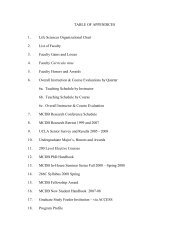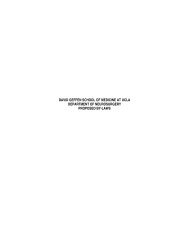Departmental Self Review - UCLA Academic Senate
Departmental Self Review - UCLA Academic Senate
Departmental Self Review - UCLA Academic Senate
- No tags were found...
Create successful ePaper yourself
Turn your PDF publications into a flip-book with our unique Google optimized e-Paper software.
Patient Care Technology; Essential V: Health Care Policy, Finance, and Regulatory Environments;Essential VI: Interprofessional Communication and Collaboration For Improving Patient HealthOutcomes; Essential VII: Clinical Prevention and Population Health; Essential VIII: Professionalismand Professional Values: and Essential IX: Baccalaureate Generalist Nursing Practice. Baccalaureateeducation provides entry to graduate education and the preparation of scholars to develop the science ofnursing.The SON’s two structural pathways to baccalaureate education include the Generic BS degree, a fouryear pre-licensure program, and the three year BS/MSN Bridge program, a post licensure program.Student admissions to the Generic BS program were initiated in 1949 and suspended in 1996 duringextreme state-wide budget cuts to the University. To fulfill obligations to society, as well as to maintainthe BS degree, in 1997 Registered Nurses (RNs) educated in community colleges earning Associate ofArts degrees were admitted to the newly developed RN-BS-MSN Bridge program. Responding to thecritical nursing shortage in California, Governor Arnold Swartzenegger, in January of 2006, approvedfunding for the University of California (UC) Board of Regents to permit the <strong>UCLA</strong> SON to re-openadmissions to the Generic BS program. In September 2006, 59 freshmen students were admitted to thisprogram.Availability of state funds to reopen admissions to the Generic BS program was announced in May,2006 with the stipulation that funds would be awarded based on a minimum enrollment of 50 newstudents each year. In view of both technological advancements and changes in nursing practice, thecurriculum of the Generic BS program was redesigned to obtain the <strong>Academic</strong> <strong>Senate</strong>’s approval and toreceive the state funds. To accomplish this task expeditiously, the faculty reviewed and adapted theMECN curriculum for the Generic BS program with lower and upper division course numbers asappropriate.2. Strengths and Weaknesses of the Program. The strengths of the Generic BS program relateto the integration of liberal arts courses and the nursing courses throughout the four years. The programis based in the sciences with a strong emphasis on the ability of the student to make critical and logicalassessments of information; deliver reasonable and persuasive arguments; and identify, acquire, and usethe knowledge necessary to solve problems. Students learn the art and science of nursing using the latestresearch findings to guide their practice. The students are satisfied with the level of personal contact thatthe program provides. A Student Affairs Undergraduate Student Services Coordinator serves as anacademic advisor during the first two years of the program; a level of contact that our students highlyvalue. The students have been very instrumental in helping the faculty to design a type of program that isstudent-friendly, and at the same time, strongly academic in focus. In fall quarter 2008, the first cohort ofstudents will begin the nursing theory and clinical courses. Their performance on the NationalCertification License examination (NCLEX) will be known in early summer 2010.Challenges in implementing the program relate to maintaining coherence of the curriculum. Forexample, in some of the science courses, the administrative grading of courses makes the curriculum lessresponsive to the needs of the students. In chemistry and life sciences, for example, every time a studentdrops the course, the curve changes; thus students who are experiencing content-related challenges arefurther lowered in terms of ranking.The coherence of the curriculum has also posed challenges from outside departments. For example,budgetary constraints of recent years make some science departments willing to offer pre-requisitecourses, e.g., anatomy and physiology, only in summer months when fees are substantially higher.Another challenge for students was meeting the requirement for Writing II. A majority of students foundit difficult to enroll in a Writing II course due to lack of course availability. We solved this problem by11



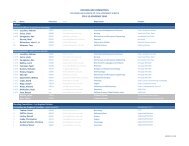
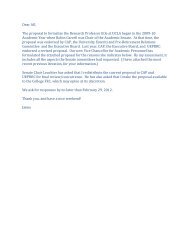
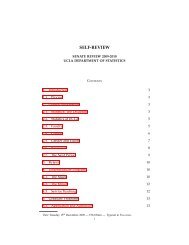
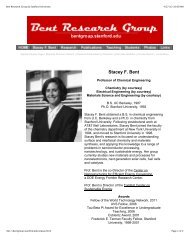

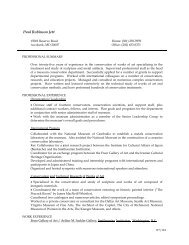


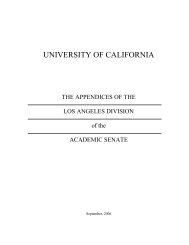
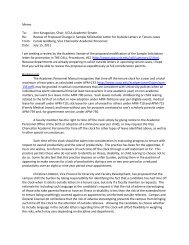
![Schedule[Final] Summer Sessions - UCLA Academic Senate](https://img.yumpu.com/42025221/1/190x245/schedulefinal-summer-sessions-ucla-academic-senate.jpg?quality=85)
